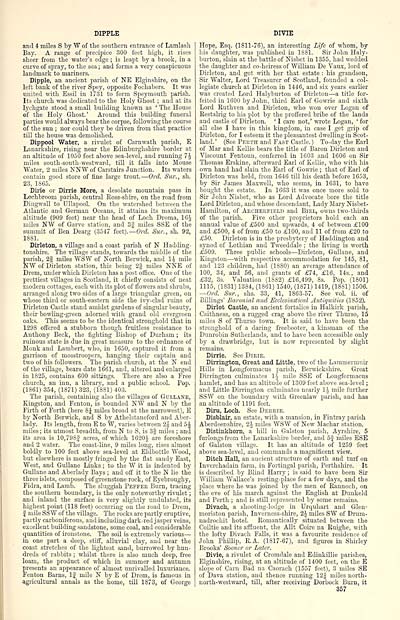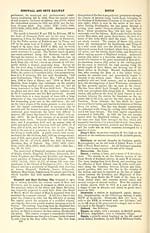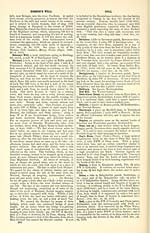Ordnance gazetteer of Scotland > Volume 2
(103) Page 357 - DIP
Download files
Complete book:
Individual page:
Thumbnail gallery: Grid view | List view

DIPPLE
DIVIE
and 4 miles S by W of the southern entrance of Lamlash
Bay. A range of precipice 300 feet high, it rises
sheer from the water's edge ; is leapt by a brook, in a
curve of spray, to the sea ; and forms a very conspicuous
landmark to mariners.
Dipple, an ancient parish of NE Elginshire, on the
left bank of the river Spey, opposite Fochabers. It was
united with Essil in 1731 to form Speymouth parish.
Its church was dedicated to the Holy Ghost ; and at its
lychgate stood a small building known as ' The House
of the Holy Ghost.' Around this building funeral
parties would always bear the corpse, following the course
of the sun ; nor could they be driven from that practice
till the house was demolished.
Dippool Water, a rivulet of Carnwath parish, E
Lanarkshire, rising near the Edinburghshire border at
an altitude of 1050 feet above sea-level, and running 7J
miles south-south-westward, till it falls into Mouse
Water, 2 miles NKW of Carstairs Junction. Its waters
contain good store of tine large trout. — Ord. Sur., sh.
23, 1865.
Dirie or Dirrie More, a desolate mountain pass in
Lochbroom parish, central Eoss-shire, on the road from
Dingwall to Ullapool. On the watershed between the
Atlantic and German Oceans, it attains its maximum
altitude (909 feet) near the head of Loch Droma, 16J
miles NW of Garve station, and 3J miles SSE of the
summit of Ben Dearg (3517 feet). — Ord. Su?\, sh. 92,
1881.
Dirleton, a village and a coast parish of N Hadding-
tonshire. The village stands, towards the middle of the
parish, 2| miles WSW of North Berwick, and 1| mile
NW of Dirleton station, this being 2§ miles NNE of
Dreni, under which Dirleton has a post office. One of the
prettiest villages in Scotland, it chiefly consists of neat
modern cottages, each with its plot of flowers and shrubs,
arranged along two sides of a large triangular green, on
whose third or south-eastern side the ivy-clad ruins of
Dirleton Castle stand amidst gardens of singular beauty,
their bowling-green adorned with grand old evergreen
oaks. This seems to be the identical stronghold that in
1298 offered a stubborn though fruitless resistance to
Anthony Beck, the fighting Bishop of Durham ; its
ruinous state is due in great measure to the ordnance of
Monk and Lambert, who, in 1650, captured it from a
garrison of mosstroopers, hanging their captain and
two of his followers. The parish church, at the N end
of the village, bears date 1661, and, altered and enlarged
in 1825, contains 600 sittings. There are also a Free
church, an inn, a library, and a public school. Pop.
(1861) 354, (1871) 323, (1SS1) 403.
The parish, containing also the villages of Gullane,
Kingston, and Fenton, is bounded NW and N by the
Firtli of Forth (here 8J miles broad at the narrowest), E
by North Berwick, and S by Athelstaneford and Aber-
lady. Its length, from E to W, varies between 2J and 5^
miles ; its utmost breadth, from N to S, is 3§ miles ; and
its area is 10,798J acres, of which 1620J are foreshore
and 2 water. The coast-line, 9 miles long, rises almost
boldly to 100 feet above sea-level at Eldbottle Wood,
but elsewhere is mostly fringed by the flat sandy East,
West, and Gullane Links ; to the W it is indented by
Gullane and Aberlady Bays ; and off it to the N lie the
three islets, composed of greenstone rock, of Eyebroughy,
Fidra, and Lamb. The sluggish Peffer Burn, tracing
the southern boundary, is the only noteworthy rivulet ;
and inland the surface is very slightly undulated, its
highest point (118 feet) occurring on the road to Drem,
J mile SSW of the village. The rocks are partly eruptive,
partly carboniferous, and including dark-red jasper veins,
excellent building sandstone, some coal, and considerable
quantities of ironstone. The soil is extremely various —
in one part a deep, stiff, alluvial clay, and near the
coast stretches of the lightest sand, burrowed by hun-
dreds of rabbits ; whilst there is also much deep, free
loam, the product of which in summer and autumn
presents an appearance of almost unrivalled luxuriance.
Fenton Barns, If mile N by E of Drem, is famous in
agricultural annals as the home, till 1873, of George
Hope, Esq. (1811-76), an interesting Life of whom, by
his daughter, was published in 1881. Sir John Haly-
burton, slain at the battle of Nisbet in 1355, had wedded
the daughter and co-heiress of William De Vaux, lord of
Dirleton, and got with her that estate : his grandson,
Sir Walter, Lord Treasurer of Scotland, founded a col-
legiate church at Dirleton in 1446, and six years earlier
was created Lord Halyburton of Dirleton — a title for-
feited in 1600 by John, third Earl of Gowrie and sixth
Lord Euthven and Dirleton, who won over Logan of
Eestalrig to his plot by the proffered bribe of the lands
and castle of Dirleton. ' I care not,' wrote Logan, ' for
all else I have in this kingdom, in case I get grip of
Dirleton, for I esteem it the pleasantest dwelling in Scot-
land.' (See Perth and Fast Castle. ) To-day the Earl
of Mar and Kellie bears the title of Baron Dirleton and
Viscount Fentoun, conferred in 1603 and 1606 on Sir
Thomas Erskine, afterward Earl of Kellie, who with his
own hand had slain the Earl of Gowrie ; that of Earl of
Dirleton was held, from 1646 till his death before 1653,
by Sir James Maxwell, who seems, in 1631, to have
bought the estate. In 1663 it was once more sold to
Sir John Nisbet, who as Lord Advocate bore the title
Lord Dirleton, and whose descendant, Lady Mary Nisbet-
Hamilton, of Archerfield and Biel, owns two-thirds
of the parish. Five other proprietors hold each an
annual value of £500 and upwards, 4 of between £100
and £500, 4 of from £50 to £100, and 11 of from £20 to
£50. Dirleton is in the presbytery of Haddington and
synod of Lothian and Tweeddale ; the living is worth
£509. Three public schools — Dirleton, Gullane, and
Kingston — with respective accommodation for 145, 81,
and 123 children, had (1S80) an average attendance of
100, 34, and 56, and grants of £74, £16, 14s., and
£32, 3s. Valuation (1882) £16,499, 8s. Pop. (1801)
1115, (1831) 1384, (1861) 1540, (1871) 1419, (1881) 1506.
— Ord. Sur., shs. 33, 41, 1S63-57. See vol. ii. of
Billings' Baronial and Ecclesiastical Antiquities (1852).
Dirlot Castle, an ancient fortalice in Halkirk parish,
Caithness, on a rugged crag above the river Thurso, 15
miles S of Thurso town. It is said to have been the
stronghold of a daring freebooter, a kinsman of the
Dunrobin Sutherlands, and to have been accessible only
by a drawbridge, but is now represented by slight
remains.
Dirrie. See Dirie.
Dirrington, Great and Little, two of the Lammermuir
Hills in Longformacus parish, Berwickshire. Great
Dirrington culminates if mile SSE of Longformacus
hamlet, and has an altitude of 1309 feet above sea-level ;
aud Little Dirrington culminates nearly 11 mile further
SSW on the boundary with Greenlaw parish, and has
an altitude of 1191 feet.
Diru, Loch. See Derrie.
Disblair, an estate, with a mansion, in Fintray parish
Aberdeenshire, 2J miles WSW of New Machar station.
Distinkhorn, a hill in Galston parish, Ayrshire, 5
furlongs from the Lanarkshire border, and 5f miles ESE
of Galston village. It has an altitude of 1259 feet
above sea-level, and commands a magnificent view.
Ditch Hall, an ancient structure of earth and turf on
Inverchadain farm, in Fortingal parish, Perthshire. It
is described by Blind Harry ; is said to have been Sir
William Wallace's resting-place for a few days, and the
place where he was joined by the men of Eannoch , on
the eve of his march against the English at Dunkeld
and Perth ; and is still represented by some remains.
Divach, a shooting-lodge in Urquhart and Glen-
moriston parish, Inverness-shire, 2i miles SW of Druni-
nadrochit hotel. Komantically situated between the
Coiltie and its affluent, the Allt Coire na Euighe, with
the lofty Divach Falls, it was a favourite residence of
John Phillip, R.A. (1817-67), and figures in Shirley
Brooks' Sooner or Later.
Divie, a rivulet of Cromdale and Edinkillie parishes,
Elginshire, rising, at an altitude of 1400 feet, on the E
slope of Cam Bad na Caorach (1557 feet), 3 miles SE
of Dava station, and thence running 12J miles north-
north-westward, till, after receiving Dorbock Burn, it
357
DIVIE
and 4 miles S by W of the southern entrance of Lamlash
Bay. A range of precipice 300 feet high, it rises
sheer from the water's edge ; is leapt by a brook, in a
curve of spray, to the sea ; and forms a very conspicuous
landmark to mariners.
Dipple, an ancient parish of NE Elginshire, on the
left bank of the river Spey, opposite Fochabers. It was
united with Essil in 1731 to form Speymouth parish.
Its church was dedicated to the Holy Ghost ; and at its
lychgate stood a small building known as ' The House
of the Holy Ghost.' Around this building funeral
parties would always bear the corpse, following the course
of the sun ; nor could they be driven from that practice
till the house was demolished.
Dippool Water, a rivulet of Carnwath parish, E
Lanarkshire, rising near the Edinburghshire border at
an altitude of 1050 feet above sea-level, and running 7J
miles south-south-westward, till it falls into Mouse
Water, 2 miles NKW of Carstairs Junction. Its waters
contain good store of tine large trout. — Ord. Sur., sh.
23, 1865.
Dirie or Dirrie More, a desolate mountain pass in
Lochbroom parish, central Eoss-shire, on the road from
Dingwall to Ullapool. On the watershed between the
Atlantic and German Oceans, it attains its maximum
altitude (909 feet) near the head of Loch Droma, 16J
miles NW of Garve station, and 3J miles SSE of the
summit of Ben Dearg (3517 feet). — Ord. Su?\, sh. 92,
1881.
Dirleton, a village and a coast parish of N Hadding-
tonshire. The village stands, towards the middle of the
parish, 2| miles WSW of North Berwick, and 1| mile
NW of Dirleton station, this being 2§ miles NNE of
Dreni, under which Dirleton has a post office. One of the
prettiest villages in Scotland, it chiefly consists of neat
modern cottages, each with its plot of flowers and shrubs,
arranged along two sides of a large triangular green, on
whose third or south-eastern side the ivy-clad ruins of
Dirleton Castle stand amidst gardens of singular beauty,
their bowling-green adorned with grand old evergreen
oaks. This seems to be the identical stronghold that in
1298 offered a stubborn though fruitless resistance to
Anthony Beck, the fighting Bishop of Durham ; its
ruinous state is due in great measure to the ordnance of
Monk and Lambert, who, in 1650, captured it from a
garrison of mosstroopers, hanging their captain and
two of his followers. The parish church, at the N end
of the village, bears date 1661, and, altered and enlarged
in 1825, contains 600 sittings. There are also a Free
church, an inn, a library, and a public school. Pop.
(1861) 354, (1871) 323, (1SS1) 403.
The parish, containing also the villages of Gullane,
Kingston, and Fenton, is bounded NW and N by the
Firtli of Forth (here 8J miles broad at the narrowest), E
by North Berwick, and S by Athelstaneford and Aber-
lady. Its length, from E to W, varies between 2J and 5^
miles ; its utmost breadth, from N to S, is 3§ miles ; and
its area is 10,798J acres, of which 1620J are foreshore
and 2 water. The coast-line, 9 miles long, rises almost
boldly to 100 feet above sea-level at Eldbottle Wood,
but elsewhere is mostly fringed by the flat sandy East,
West, and Gullane Links ; to the W it is indented by
Gullane and Aberlady Bays ; and off it to the N lie the
three islets, composed of greenstone rock, of Eyebroughy,
Fidra, and Lamb. The sluggish Peffer Burn, tracing
the southern boundary, is the only noteworthy rivulet ;
and inland the surface is very slightly undulated, its
highest point (118 feet) occurring on the road to Drem,
J mile SSW of the village. The rocks are partly eruptive,
partly carboniferous, and including dark-red jasper veins,
excellent building sandstone, some coal, and considerable
quantities of ironstone. The soil is extremely various —
in one part a deep, stiff, alluvial clay, and near the
coast stretches of the lightest sand, burrowed by hun-
dreds of rabbits ; whilst there is also much deep, free
loam, the product of which in summer and autumn
presents an appearance of almost unrivalled luxuriance.
Fenton Barns, If mile N by E of Drem, is famous in
agricultural annals as the home, till 1873, of George
Hope, Esq. (1811-76), an interesting Life of whom, by
his daughter, was published in 1881. Sir John Haly-
burton, slain at the battle of Nisbet in 1355, had wedded
the daughter and co-heiress of William De Vaux, lord of
Dirleton, and got with her that estate : his grandson,
Sir Walter, Lord Treasurer of Scotland, founded a col-
legiate church at Dirleton in 1446, and six years earlier
was created Lord Halyburton of Dirleton — a title for-
feited in 1600 by John, third Earl of Gowrie and sixth
Lord Euthven and Dirleton, who won over Logan of
Eestalrig to his plot by the proffered bribe of the lands
and castle of Dirleton. ' I care not,' wrote Logan, ' for
all else I have in this kingdom, in case I get grip of
Dirleton, for I esteem it the pleasantest dwelling in Scot-
land.' (See Perth and Fast Castle. ) To-day the Earl
of Mar and Kellie bears the title of Baron Dirleton and
Viscount Fentoun, conferred in 1603 and 1606 on Sir
Thomas Erskine, afterward Earl of Kellie, who with his
own hand had slain the Earl of Gowrie ; that of Earl of
Dirleton was held, from 1646 till his death before 1653,
by Sir James Maxwell, who seems, in 1631, to have
bought the estate. In 1663 it was once more sold to
Sir John Nisbet, who as Lord Advocate bore the title
Lord Dirleton, and whose descendant, Lady Mary Nisbet-
Hamilton, of Archerfield and Biel, owns two-thirds
of the parish. Five other proprietors hold each an
annual value of £500 and upwards, 4 of between £100
and £500, 4 of from £50 to £100, and 11 of from £20 to
£50. Dirleton is in the presbytery of Haddington and
synod of Lothian and Tweeddale ; the living is worth
£509. Three public schools — Dirleton, Gullane, and
Kingston — with respective accommodation for 145, 81,
and 123 children, had (1S80) an average attendance of
100, 34, and 56, and grants of £74, £16, 14s., and
£32, 3s. Valuation (1882) £16,499, 8s. Pop. (1801)
1115, (1831) 1384, (1861) 1540, (1871) 1419, (1881) 1506.
— Ord. Sur., shs. 33, 41, 1S63-57. See vol. ii. of
Billings' Baronial and Ecclesiastical Antiquities (1852).
Dirlot Castle, an ancient fortalice in Halkirk parish,
Caithness, on a rugged crag above the river Thurso, 15
miles S of Thurso town. It is said to have been the
stronghold of a daring freebooter, a kinsman of the
Dunrobin Sutherlands, and to have been accessible only
by a drawbridge, but is now represented by slight
remains.
Dirrie. See Dirie.
Dirrington, Great and Little, two of the Lammermuir
Hills in Longformacus parish, Berwickshire. Great
Dirrington culminates if mile SSE of Longformacus
hamlet, and has an altitude of 1309 feet above sea-level ;
aud Little Dirrington culminates nearly 11 mile further
SSW on the boundary with Greenlaw parish, and has
an altitude of 1191 feet.
Diru, Loch. See Derrie.
Disblair, an estate, with a mansion, in Fintray parish
Aberdeenshire, 2J miles WSW of New Machar station.
Distinkhorn, a hill in Galston parish, Ayrshire, 5
furlongs from the Lanarkshire border, and 5f miles ESE
of Galston village. It has an altitude of 1259 feet
above sea-level, and commands a magnificent view.
Ditch Hall, an ancient structure of earth and turf on
Inverchadain farm, in Fortingal parish, Perthshire. It
is described by Blind Harry ; is said to have been Sir
William Wallace's resting-place for a few days, and the
place where he was joined by the men of Eannoch , on
the eve of his march against the English at Dunkeld
and Perth ; and is still represented by some remains.
Divach, a shooting-lodge in Urquhart and Glen-
moriston parish, Inverness-shire, 2i miles SW of Druni-
nadrochit hotel. Komantically situated between the
Coiltie and its affluent, the Allt Coire na Euighe, with
the lofty Divach Falls, it was a favourite residence of
John Phillip, R.A. (1817-67), and figures in Shirley
Brooks' Sooner or Later.
Divie, a rivulet of Cromdale and Edinkillie parishes,
Elginshire, rising, at an altitude of 1400 feet, on the E
slope of Cam Bad na Caorach (1557 feet), 3 miles SE
of Dava station, and thence running 12J miles north-
north-westward, till, after receiving Dorbock Burn, it
357
Set display mode to: Large image | Transcription
Images and transcriptions on this page, including medium image downloads, may be used under the Creative Commons Attribution 4.0 International Licence unless otherwise stated. ![]()
| Gazetteers of Scotland, 1803-1901 > Ordnance gazetteer of Scotland > Volume 2 > (103) Page 357 - DIP |
|---|
| Permanent URL | https://digital.nls.uk/97374014 |
|---|
| Attribution and copyright: |
|
|---|---|

